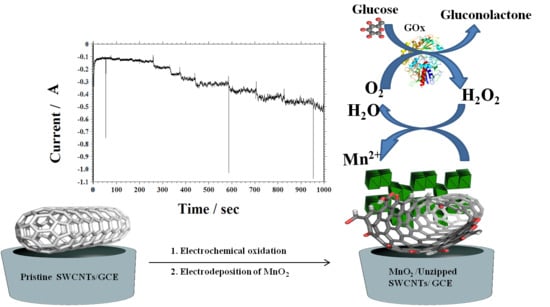Electrochemically Prepared Unzipped Single Walled Carbon Nanotubes-MnO2 Nanostructure Composites for Hydrogen Peroxide and Glucose Sensing
Abstract
1. Introduction
2. Materials and Methods
2.1. Reagents and Apparatus
2.2. Preparation of MnO2/Unzipped SWCNTs/GCE
3. Results and Discussion
3.1. Characterization of Unzipped SWCNTs and MnO2 Nanostructured Film
3.2. Formation of MnO2 on Unzipped SWCNTs/GCE
3.3. Electrocatalytic Oxidation of H2O2 at MnO2/Unzipped SWCNTs/GCE
3.4. Determination of H2O2
3.5. Application of MnO2/Unzipped SWCNTs/GCE in Glucose Sensing
3.6. Selectivity, Stability and Reproducibility Property of the MnO2/Unzipped SWCNTs/GCE
4. Conclusions
Author Contributions
Funding
Acknowledgments
Conflicts of Interest
References
- Kim, N.D.; Li, Y.; Wang, G.; Fan, X.; Jiang, J.; Li, L.; Ji, Y.; Ruan, G.; Hauge, R.H.; Tour, J.M. Growth and Transfer of Seamless 3D Graphene–Nanotube Hybrids. Nano Lett. 2016, 16, 1287–1292. [Google Scholar] [CrossRef] [PubMed]
- Kosynkin, D.V.; Higginbotham, A.L.; Sinitskii, A.; Lomeda, J.R.; Dimiev, A.; Price, B.K.; Tour, J.M. Longitudinal unzipping of carbon nanotubes to form graphene nanoribbons. Nature 2009, 458, 872–876. [Google Scholar] [CrossRef] [PubMed]
- John, R.; Shinde, D.B.; Liu, L.; Ding, F.; Xu, Z.; Vijayan, C.; Pillai, V.K.; Pradeep, T. Sequential Electrochemical Unzipping of Single-Walled Carbon Nanotubes to Graphene Ribbons Revealed by in Situ Raman Spectroscopy and Imaging. ACS Nano 2014, 8, 234–242. [Google Scholar] [CrossRef] [PubMed]
- Li, Y.; Zhou, W.; Wang, H.; Xie, L.; Liang, Y.; Wei, F.; Idrobo, J.-C.; Pennycook, S.J.; Dai, H. An oxygen reduction electrocatalyst based on carbon nanotube-graphene complexes. Nat. Nano 2012, 7, 394–400. [Google Scholar] [CrossRef] [PubMed]
- Deilmann, T.; Rohlfing, M. Huge Trionic Effects in Graphene Nanoribbons. Nano Lett. 2017, 17, 6833–6837. [Google Scholar] [CrossRef]
- Chen, X.; Xu, Y.; Zou, X.; Gu, B.-L.; Duan, W. Interfacial thermal conductance of partially unzipped carbon nanotubes: Linear scaling and exponential decay. Phys. Rev. B 2013, 87, 155438. [Google Scholar] [CrossRef]
- Ervasti, M.M.; Fan, Z.; Uppstu, A.; Krasheninnikov, A.V.; Harju, A. Silicon and silicon-nitrogen impurities in graphene: Structure, energetics, and effects on electronic transport. Phys. Rev. B 2015, 92, 235412. [Google Scholar] [CrossRef]
- Chen, X.; Zhang, L.; Guo, H. Valley caloritronics and its realization by graphene nanoribbons. Phys. Rev. B 2015, 92, 155427. [Google Scholar] [CrossRef]
- Yan, Z.; Peng, Z.; Casillas, G.; Lin, J.; Xiang, C.; Zhou, H.; Yang, Y.; Ruan, G.; Raji, A.-R.O.; Samuel, E.L.G.; et al. Rebar Graphene. ACS Nano 2014, 8, 5061–5068. [Google Scholar] [CrossRef]
- Candini, A.; Martini, L.; Chen, Z.; Mishra, N.; Convertino, D.; Coletti, C.; Narita, A.; Feng, X.; Müllen, K.; Affronte, M. High Photoresponsivity in Graphene Nanoribbon Field-Effect Transistor Devices Contacted with Graphene Electrodes. J. Phys. Chem. C 2017, 121, 10620–10625. [Google Scholar] [CrossRef]
- Wei, D.; Xie, L.; Lee, K.K.; Hu, Z.; Tan, S.; Chen, W.; Sow, C.H.; Chen, K.; Liu, Y.; Wee, A.T.S. Controllable unzipping for intramolecular junctions of graphene nanoribbons and single-walled carbon nanotubes. Nat. Commun. 2013, 4, 1374. [Google Scholar] [CrossRef]
- Long, D.; Li, W.; Qiao, W.; Miyawaki, J.; Yoon, S.-H.; Mochida, I.; Ling, L. Partially unzipped carbon nanotubes as a superior catalyst support for PEM fuel cells. Chem. Commun. 2011, 47, 9429–9431. [Google Scholar] [CrossRef] [PubMed]
- Costamagna, S.; Schulz, A.; Covaci, L.; Peeters, F. Partially unzipped carbon nanotubes as magnetic field sensors. Appl. Phys. Lett. 2012, 100, 232104. [Google Scholar] [CrossRef]
- Jiao, L.; Zhang, L.; Wang, X.; Diankov, G.; Dai, H. Narrow graphene nanoribbons from carbon nanotubes. Nature 2009, 458, 877–880. [Google Scholar] [CrossRef] [PubMed]
- Talyzin, A.V.; Luzan, S.; Anoshkin, I.V.; Nasibulin, A.G.; Jiang, H.; Kauppinen, E.I.; Mikoushkin, V.M.; Shnitov, V.V.; Marchenko, D.E.; Noréus, D. Hydrogenation, Purification, and Unzipping of Carbon Nanotubes by Reaction with Molecular Hydrogen: Road to Graphane Nanoribbons. ACS Nano 2011, 5, 5132–5140. [Google Scholar] [CrossRef] [PubMed]
- Kosynkin, D.V.; Lu, W.; Sinitskii, A.; Pera, G.; Sun, Z.; Tour, J.M. Highly Conductive Graphene Nanoribbons by Longitudinal Splitting of Carbon Nanotubes Using Potassium Vapor. ACS Nano 2011, 5, 968–974. [Google Scholar] [CrossRef] [PubMed]
- Elías, A.L.; Botello-Méndez, A.R.; Meneses-Rodríguez, D.; Jehová González, V.; Ramírez-González, D.; Ci, L.; Munoz-Sandoval, E.; Ajayan, P.M.; Terrones, H.; Terrones, M. Longitudinal cutting of pure and doped carbon nanotubes to form graphitic nanoribbons using metal clusters as nanoscalpels. Nano Lett. 2009, 10, 366–372. [Google Scholar] [CrossRef]
- Jiao, L.; Wang, X.; Diankov, G.; Wang, H.; Dai, H. Facile synthesis of high-quality graphene nanoribbons. Nat. Nanotechnol. 2010, 5, 321–325. [Google Scholar] [CrossRef]
- Zehtab Yazdi, A.; Chizari, K.; Jalilov, A.S.; Tour, J.; Sundararaj, U. Helical and Dendritic Unzipping of Carbon Nanotubes: A Route to Nitrogen-Doped Graphene Nanoribbons. ACS Nano 2015, 9, 5833–5845. [Google Scholar] [CrossRef]
- Shinde, D.B.; Debgupta, J.; Kushwaha, A.; Aslam, M.; Pillai, V.K. Electrochemical Unzipping of Multi-walled Carbon Nanotubes for Facile Synthesis of High-Quality Graphene Nanoribbons. J. Am. Chem. Soc. 2011, 133, 4168–4171. [Google Scholar] [CrossRef]
- Guo, H.-L.; Wang, X.-F.; Qian, Q.-Y.; Wang, F.-B.; Xia, X.-H. A Green Approach to the Synthesis of Graphene Nanosheets. ACS Nano 2009, 3, 2653–2659. [Google Scholar] [CrossRef] [PubMed]
- Zakaria, A.B.M.; Vasquez, E.S.; Walters, K.B.; Leszczynska, D. Functional holey graphene oxide: A new electrochemically transformed substrate material for dopamine sensing. RSC Adv. 2015, 5, 107123–107135. [Google Scholar] [CrossRef]
- Palanisamy, S.; Cheemalapati, S.; Chen, S.-M. Amperometric glucose biosensor based on glucose oxidase dispersed in multiwalled carbon nanotubes/graphene oxide hybrid biocomposite. Mater. Sci. Eng. C 2014, 34, 207–213. [Google Scholar] [CrossRef] [PubMed]
- Unnikrishnan, B.; Palanisamy, S.; Chen, S.-M. A simple electrochemical approach to fabricate a glucose biosensor based on graphene–glucose oxidase biocomposite. Biosens. Bioelectron. 2013, 39, 70–75. [Google Scholar] [CrossRef] [PubMed]
- Palanisamy, S.; Chen, S.-M.; Sarawathi, R. A novel nonenzymatic hydrogen peroxide sensor based on reduced graphene oxide/ZnO composite modified electrode. Sens. Actuators B Chem. 2012, 166–167, 372–377. [Google Scholar] [CrossRef]
- Han, Y.; Zheng, J.; Dong, S. A novel nonenzymatic hydrogen peroxide sensor based on Ag–MnO2–MWCNTs nanocomposites. Electrochim. Acta 2013, 90, 35–43. [Google Scholar] [CrossRef]
- Zakaria, A.; Leszczynska, D. Novel design of non-enzymatic sensor for rapid monitoring of hydrogen peroxide in water matrix. J. Electroanal. Chem. 2016, 766, 30–36. [Google Scholar] [CrossRef]
- Vukojević, V.; Djurdjić, S.; Ognjanović, M.; Fabián, M.; Samphao, A.; Kalcher, K.; Stanković, D.M. Enzymatic glucose biosensor based on manganese dioxide nanoparticles decorated on graphene nanoribbons. J. Electroanal. Chem. 2018, 823, 610–616. [Google Scholar] [CrossRef]
- Schachl, K.; Alemu, H.; Kalcher, K.; Moderegger, H.; Svancara, I.; Vytras, K. Amperometric determination of hydrogen peroxide with a manganese dioxide film-modified screen printed carbon electrode. Fresenius J. Anal. Chem. 1998, 362, 194–200. [Google Scholar] [CrossRef]
- Hu, Y.; Jin, J.; Wu, P.; Zhang, H.; Cai, C. Graphene–gold nanostructure composites fabricated by electrodeposition and their electrocatalytic activity toward the oxygen reduction and glucose oxidation. Electrochim. Acta 2010, 56, 491–500. [Google Scholar] [CrossRef]
- Palanisamy, S.; Devasenathipathy, R.; Chen, S.-M.; Ajmal Ali, M.; Karuppiah, C.; Balakumar, V.; Prakash, P.; Elshikh, M.S.; Al-Hemaid, F.M.A. Direct Electrochemistry of Glucose Oxidase at Reduced Graphene Oxide and β-Cyclodextrin Composite Modified Electrode and Application for Glucose Biosensing. Electroanalysis 2015, 27, 2412–2420. [Google Scholar] [CrossRef]
- Sheng, Q.; Wang, M.; Zheng, J. A novel hydrogen peroxide biosensor based on enzymatically induced deposition of polyaniline on the functionalized graphene–carbon nanotube hybrid materials. Sens. Actuators B Chem. 2011, 160, 1070–1077. [Google Scholar] [CrossRef]
- Ismail, N.S.; Le, Q.H.; Yoshikawa, H.; Saito, M.; Tamiya, E. Development of Non-enzymatic Electrochemical Glucose Sensor Based on Graphene Oxide Nanoribbon—Gold Nanoparticle Hybrid. Electrochim. Acta 2014, 146, 98–105. [Google Scholar] [CrossRef]
- Liu, M.; Liu, R.; Chen, W. Graphene wrapped Cu2O nanocubes: Non-enzymatic electrochemical sensors for the detection of glucose and hydrogen peroxide with enhanced stability. Biosens. Bioelectron. 2013, 45, 206–212. [Google Scholar] [CrossRef] [PubMed]
- Anojčić, J.; Guzsvány, V.; Vajdle, O.; Kónya, Z.; Kalcher, K. Rapid amperometric determination of H2O2 by a Pt nanoparticle/Vulcan XC72 composite-coated carbon paste electrode in disinfection and contact lens solutions. Monatshefte Chem. Chem. Mon. 2018, 149, 1727–1738. [Google Scholar] [CrossRef]
- Zakaria, A.; Leszczynska, D.; Novikov, V. (Eds.) A Facial Electrochemical Method for Preparation and Characterization of Graphene Nanoribbons from Single Walled Carbon Nanotubes. In Mordern Directions in Chemistry, Biology, Pharmacy and Biotechnology; Lviv Polytechnic Publishing House: Lviv, Ukraine, 2015; pp. 110–116. [Google Scholar]
- Dresselhaus, M.S.; Dresselhaus, G.; Jorio, A.; Souza Filho, A.G.; Saito, R. Raman spectroscopy on isolated single wall carbon nanotubes. Carbon 2002, 40, 2043–2061. [Google Scholar] [CrossRef]
- Farid, M.M.; Goudini, L.; Piri, F.; Zamani, A.; Saadati, F. Molecular imprinting method for fabricating novel glucose sensor: Polyvinyl acetate electrode reinforced by MnO2/CuO loaded on graphene oxide nanoparticles. Food Chem. 2016, 194, 61–67. [Google Scholar] [CrossRef] [PubMed]
- Si, P.; Dong, X.-C.; Chen, P.; Kim, D.-H. A hierarchically structured composite of Mn3O4/3D graphene foam for flexible nonenzymatic biosensors. J. Mater. Chem. B 2013, 1, 110–115. [Google Scholar] [CrossRef]
- Ye, Y.; Wang, P.; Dai, E.; Liu, J.; Tian, Z.; Liang, C.; Shao, G. A novel reduction approach to fabricate quantum-sized SnO2-conjugated reduced graphene oxide nanocomposites as non-enzymatic glucose sensors. Phys. Chem. Chem. Phys. 2014, 16, 8801–8807. [Google Scholar] [CrossRef]
- Lin, K.-C.; Huang, L.-H.; Chen, S.-M. Electrochemical synthesis of mixed-valence manganese/copper hybrid composite using graphene oxide and multi-walled carbon nanotubes for nonenzymatic glucose sensor. J. Electroanal. Chem. 2014, 735, 36–42. [Google Scholar] [CrossRef]
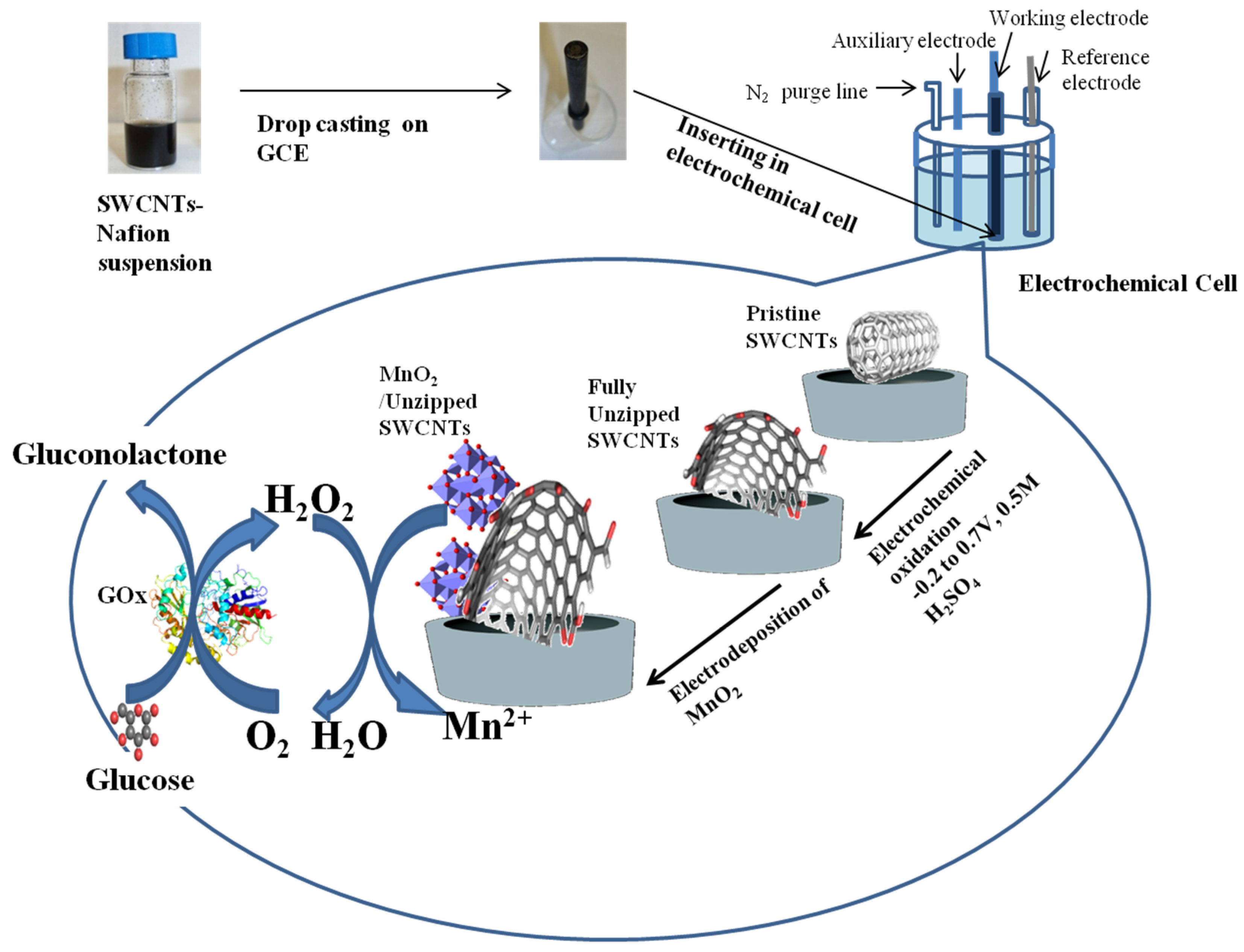
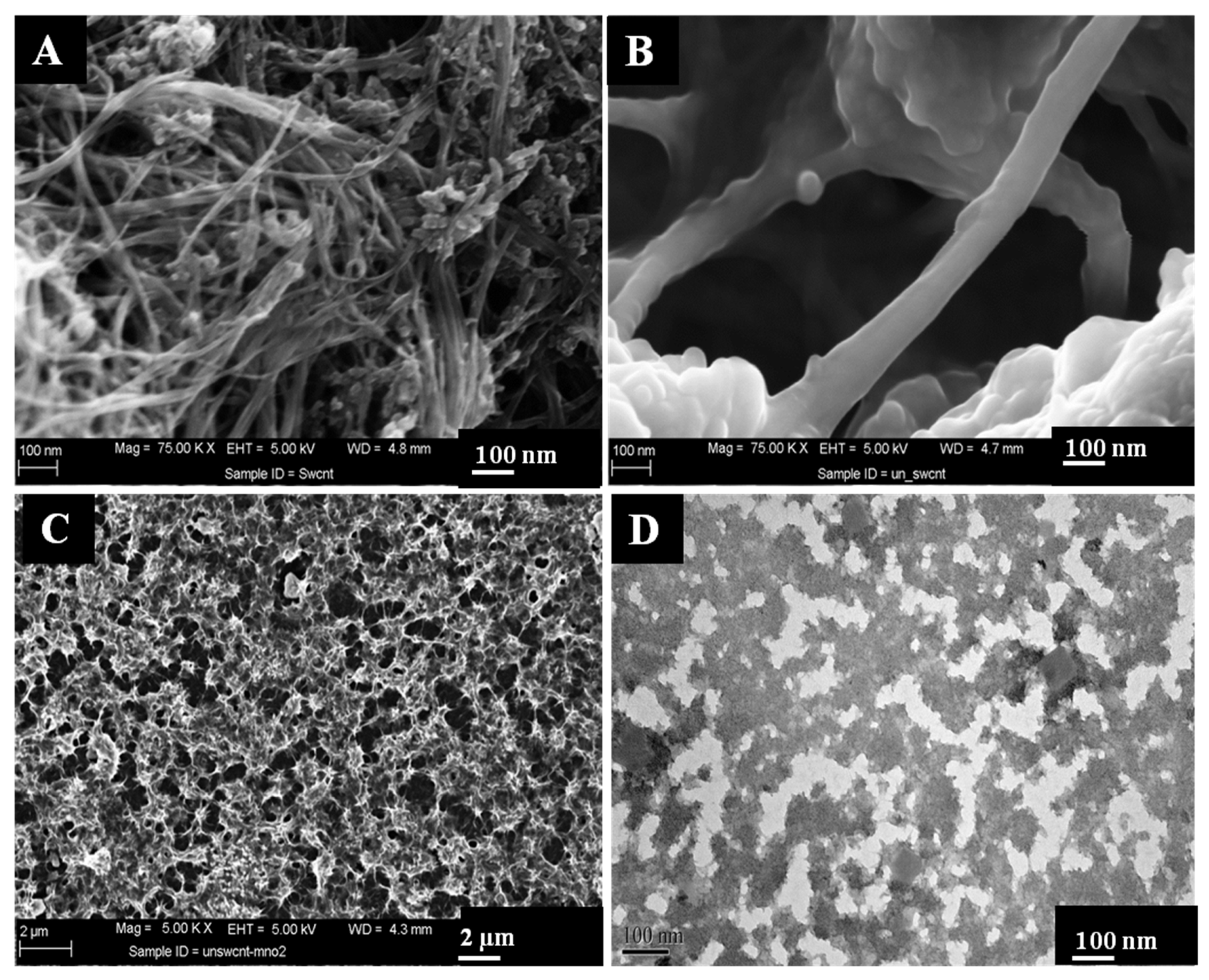
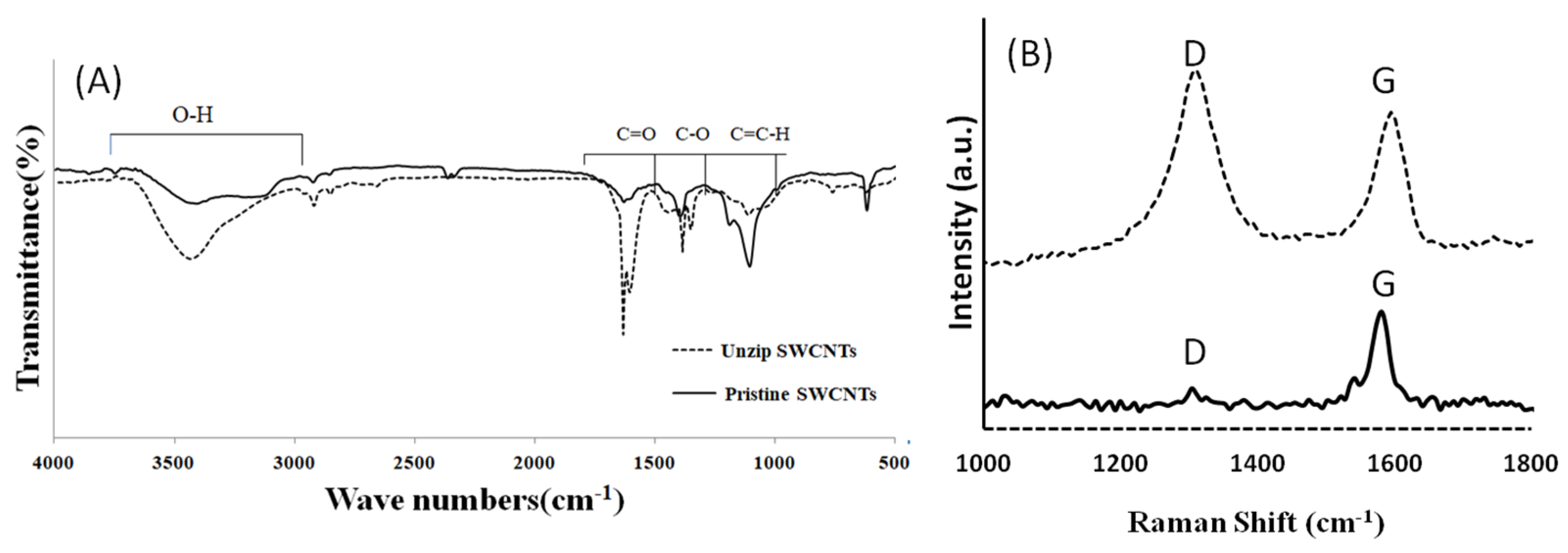
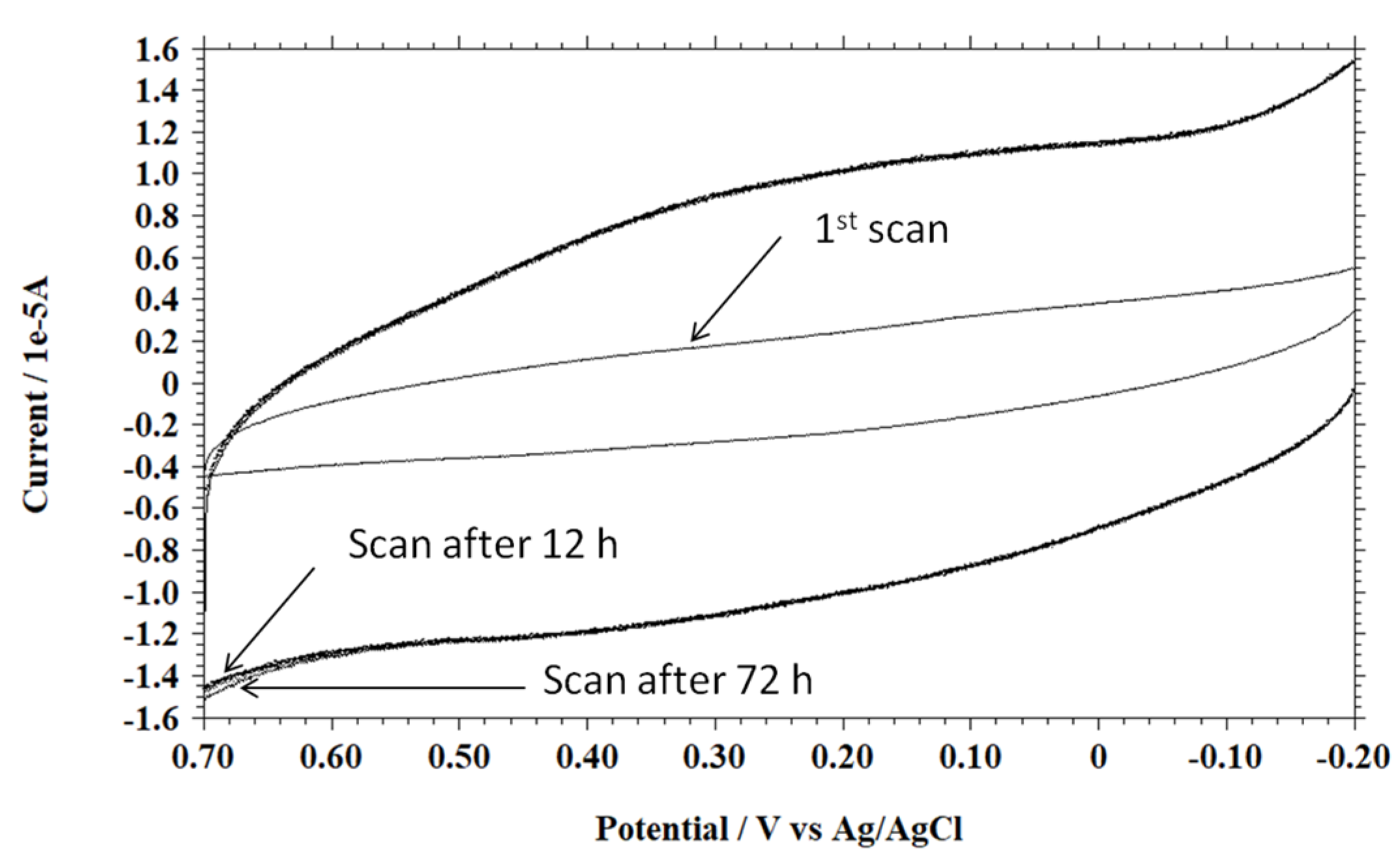


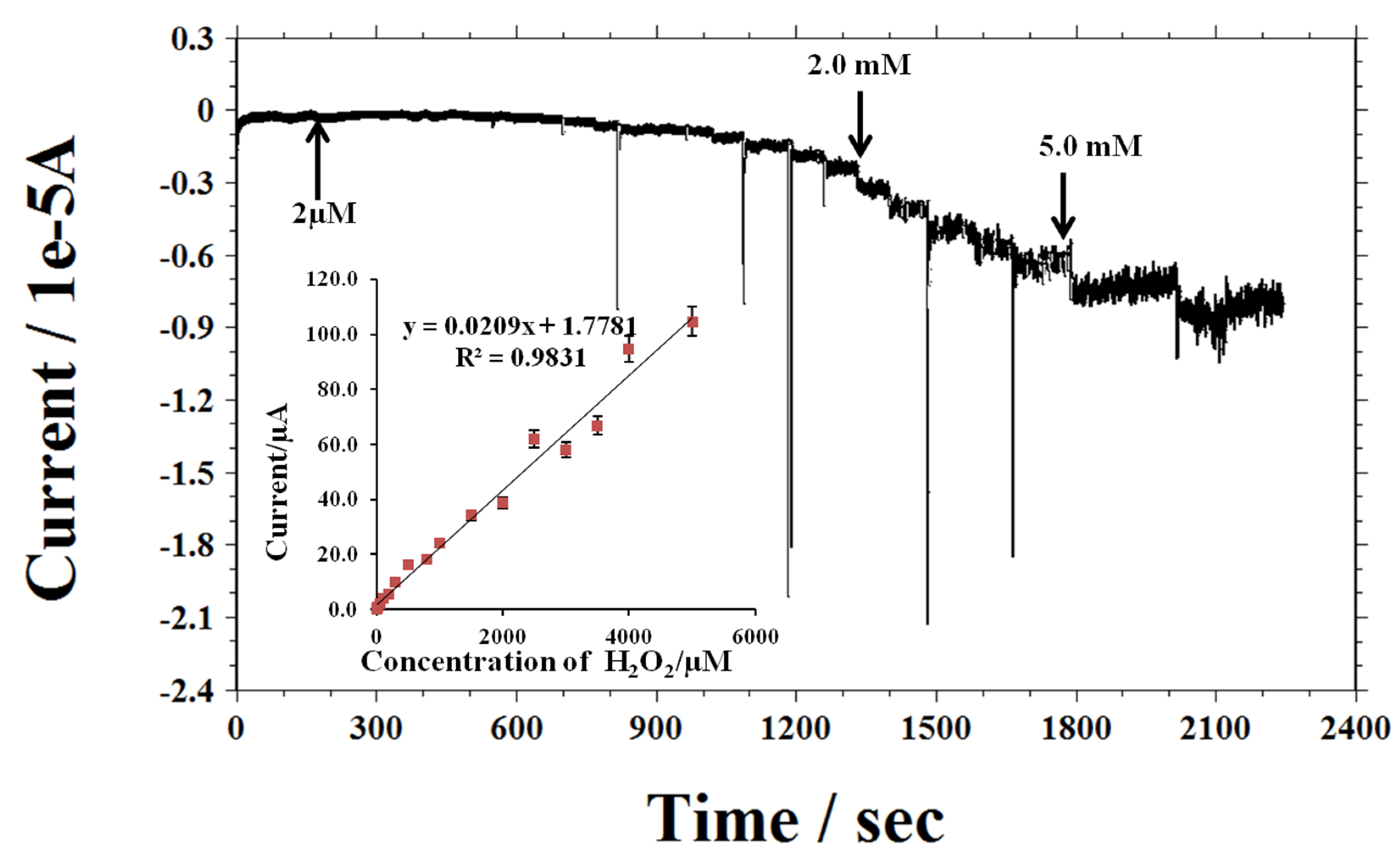
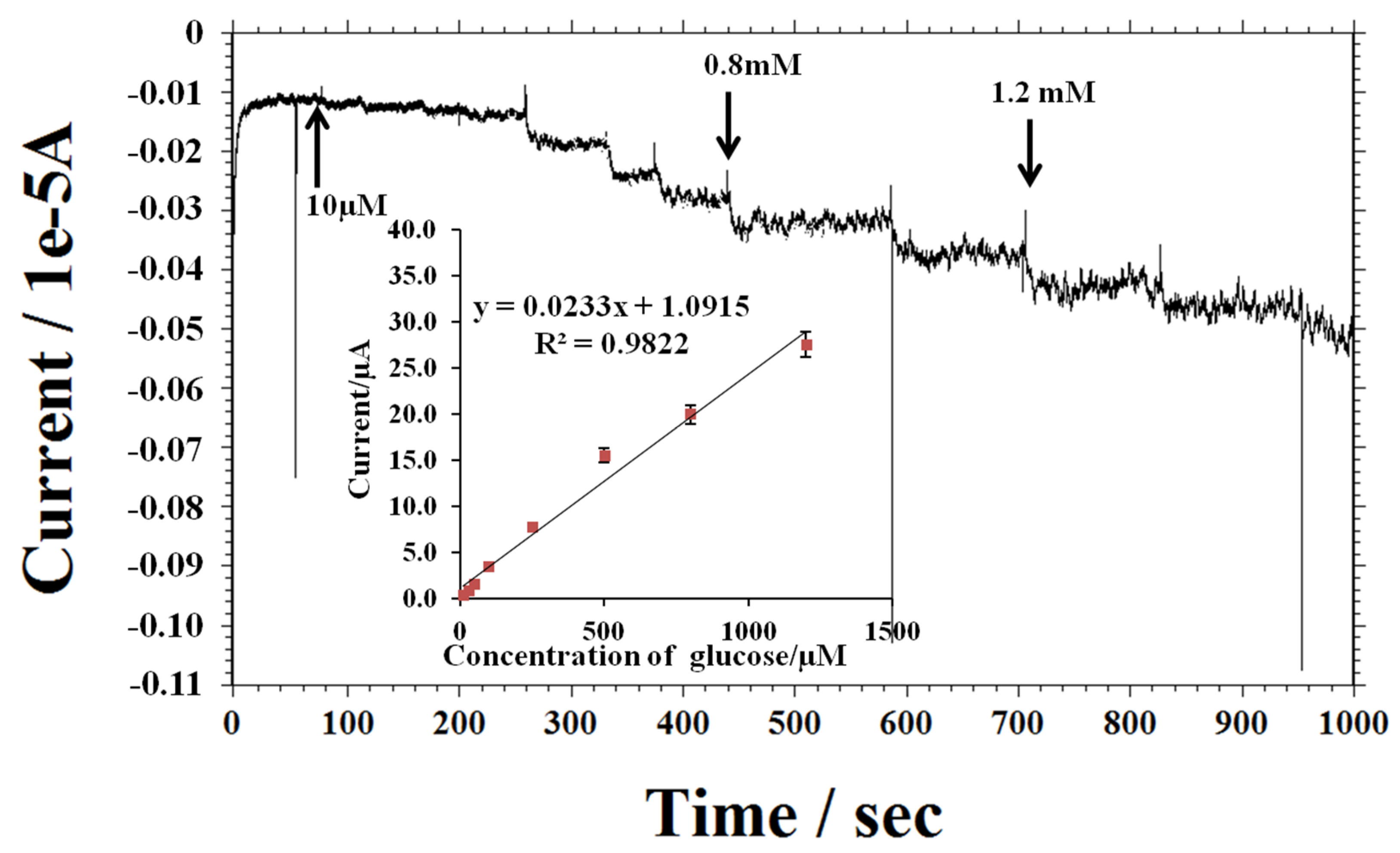
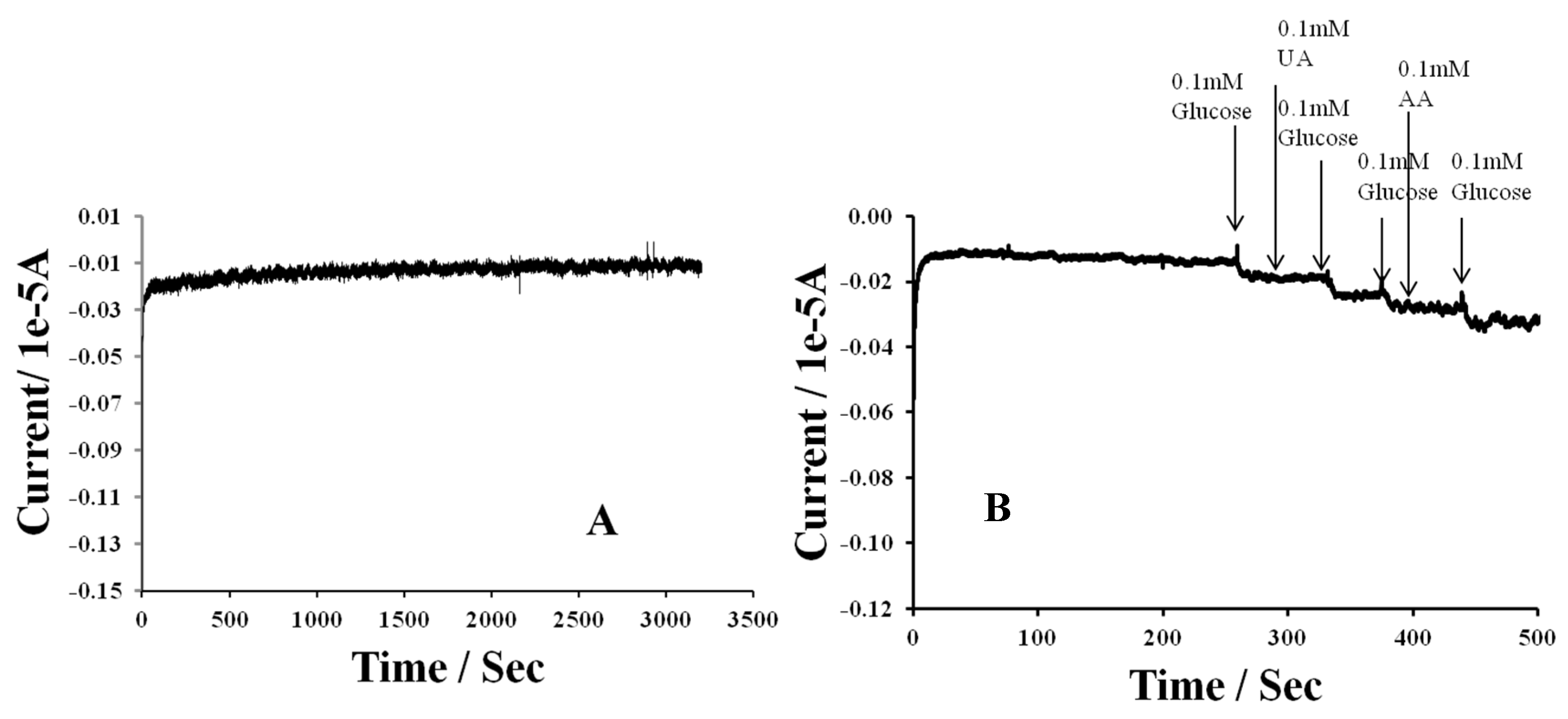
| Modified Electrode | Linear Range (mM) | Detection Limit (µM) | Reference |
|---|---|---|---|
| Pt NP/graphite-CS | 0.25–2890 µM | 66 nM | [35] |
| rGO/FeNPs/GCE | 0.001–2.15 | 0.056 | [28] |
| AgNPs/Na2Ti3O7/Graphite | 5.0–2500 | 1.0 | [29] |
| MnO2/CuO/GO NP/Cu wire | 0.5–4.4 | 53.0 | [38] |
| MnO2/SWCNTs-Nf/GCE | 0.005–3.0 | 0.52 | Our previous work [27] |
| MnO2/unzipped SWCNTs/GCE | 0.002–5.0 | 0.3 | This work |
| Modified Electrode | Linear Range (mM) | Detection Limit (µM) | Reference |
|---|---|---|---|
| Mn3O4 NP/3D GF | 0.1–8 | 10 | [39] |
| SnO2 NP/rGO/GCE | 0.05–5.00 | 13.35 | [40] |
| Mn-Cu NP/MWCNT/GCE | 1–32 | 1.0 | [41] |
| MnO2/CuO/GO NP/Cu wire | 0.5–4.4 | 53 | [38] |
| GOx/rGO/CD/GCE | 0.050–3.0 | 12 | [31] |
| MnO2/unzipped SWCNTs/GC | 0.01–1.2 | 1.2 | This work |
© 2019 by the authors. Licensee MDPI, Basel, Switzerland. This article is an open access article distributed under the terms and conditions of the Creative Commons Attribution (CC BY) license (http://creativecommons.org/licenses/by/4.0/).
Share and Cite
Zakaria, A.B.M.; Leszczynska, D. Electrochemically Prepared Unzipped Single Walled Carbon Nanotubes-MnO2 Nanostructure Composites for Hydrogen Peroxide and Glucose Sensing. Chemosensors 2019, 7, 1. https://doi.org/10.3390/chemosensors7010001
Zakaria ABM, Leszczynska D. Electrochemically Prepared Unzipped Single Walled Carbon Nanotubes-MnO2 Nanostructure Composites for Hydrogen Peroxide and Glucose Sensing. Chemosensors. 2019; 7(1):1. https://doi.org/10.3390/chemosensors7010001
Chicago/Turabian StyleZakaria, A. B. M., and Danuta Leszczynska. 2019. "Electrochemically Prepared Unzipped Single Walled Carbon Nanotubes-MnO2 Nanostructure Composites for Hydrogen Peroxide and Glucose Sensing" Chemosensors 7, no. 1: 1. https://doi.org/10.3390/chemosensors7010001
APA StyleZakaria, A. B. M., & Leszczynska, D. (2019). Electrochemically Prepared Unzipped Single Walled Carbon Nanotubes-MnO2 Nanostructure Composites for Hydrogen Peroxide and Glucose Sensing. Chemosensors, 7(1), 1. https://doi.org/10.3390/chemosensors7010001




